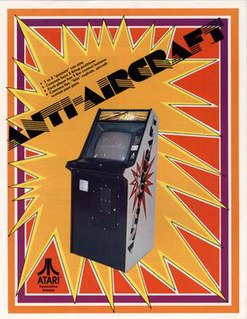 W
WAnti-Aircraft is a two-player fixed shooter released in arcades by Atari, Inc in 1975. The game was also released as Anti-Aircraft II, denoting the two-player aspect of the game.
 W
WBreakout is an arcade game developed and published by Atari, Inc., and released on May 13, 1976. It was conceptualized by Nolan Bushnell and Steve Bristow, influenced by the seminal 1972 Atari arcade game Pong, and built by Steve Wozniak.
 W
WComputer Space is a space combat arcade game developed in 1971. Created by Nolan Bushnell and Ted Dabney in partnership as Syzygy Engineering, it was the first arcade video game as well as the first commercially available video game. Computer Space is a derivative of the 1962 computer game Spacewar!, possibly the first video game to spread to multiple computer installations. It features a rocket controlled by the player engaged in a missile battle with a pair of hardware-controlled flying saucers set against a starfield background. The goal is to score more hits than the enemy spaceships within a set time period, which awards a free round of gameplay. The game is enclosed in a custom fiberglass cabinet, which Bushnell designed to look futuristic.
 W
WCrash 'N Score is a 2 player arcade game by Atari, Inc. released in 1975. A modified version of the game was released in Europe under the name Stock Car.
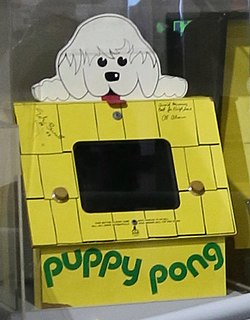 W
WDoctor Pong, also known as Puppy Pong was an adaption of the original arcade Pong for use in a non-coin-operated environment. It was conceptualized by Nolan Bushnell, Steve Bristow and a marketing firm to move their arcade games into a non-arcade environment—in this case to help occupy children in pediatricians' waiting rooms. Originally designed to be model of Snoopy's doghouse with Pong built into the side of it, when Charles Schulz declined Atari the use of Snoopy the model was changed to a generic doghouse with a puppy looking over the top. Puppy Pong saw a limited production run and was in testing stage at Chuck E. Cheese's early locations.
 W
WF-1 is a 1976 electro-mechanical racing arcade game developed and published by Namco. It was distributed by Atari, Inc. in the United States. The player uses a steering wheel to control a Formula One racer, which must avoid collision with other vehicles. The game uses a miniature diorama with small, plastic cars to represent the player's car and opponents on a physical, rotating track, while also featuring a projector system and lighting tricks to create the illusion of racing.
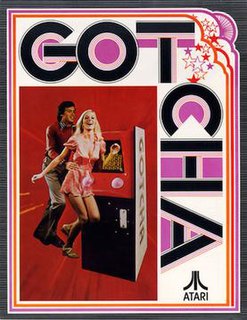 W
WGotcha is an arcade game developed by Atari and released in October 1973. It was the fourth game by the company, after the 1972 Pong, which marked the beginning of the commercial video game industry, and the 1973 Space Race and Pong Doubles. In the game, two players move through a maze, which continually changes over time. One player, the Pursuer, attempts to catch the other, the Pursued; if they do, a point is scored, and the players reset positions. The game emits an electronic beeping sound, which increases in pace as the Pursuer gets closer to the Pursued, and each game lasts a set amount of time.
 W
WHI-way is a single-player arcade game by Atari Inc., originally released in 1975. Marketed with the slogan “Hi Way — All It Needs Is Wheels,” it was Atari's first game to use a cockpit cabinet.
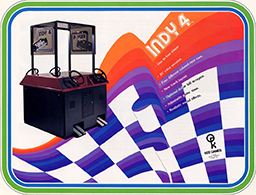 W
WIndy 4 is a 4 player arcade game by Atari, originally released in 1976. It was preceded by its larger 8 player counterpart, Indy 800, in 1975.
 W
WIndy 800 is an eight player arcade game by Atari Inc., originally released in 1975.
 W
WJet Fighter is a 2 player arcade game by Atari, originally released in 1975.
 W
WMonaco GP is an arcade racing game released by Sega in 1979. One of the last Sega games to use TTL chips instead of a CPU, the game has players race against a clock and pass rival racers while attempting to earn points driving through five areas. An upgraded version, Pro Monaco GP, was released in 1980; the series also had later releases Super Monaco GP and Ayrton Senna's Super Monaco GP II. Monaco GP was ported to the SG-1000 in 1983. The game was successful in arcades.
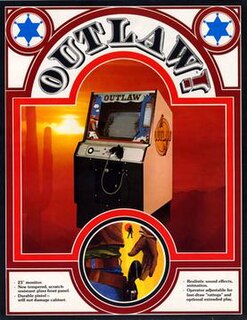 W
WOutlaw is a single-player arcade game by Atari Inc., originally released in 1976. It simulates an Old West fast draw duel between the player and the computer. Outlaw was a response to Gun Fight, released by Midway in North America the year before.
 W
WPong is a table tennis–themed arcade video game, featuring simple two-dimensional graphics, manufactured by Atari and originally released in 1972. It was one of the earliest arcade video games; it was created by Allan Alcorn as a training exercise assigned to him by Atari co-founder Nolan Bushnell, but Bushnell and Atari co-founder Ted Dabney were surprised by the quality of Alcorn's work and decided to manufacture the game. Bushnell based the game's concept on an electronic ping-pong game included in the Magnavox Odyssey, the first home video game console. In response, Magnavox later sued Atari for patent infringement.
 W
WPursuit is a single-player arcade game by Kee Games, originally released in 1975. The player plays a World War I flying ace who tries to shoot down enemy planes. Gameplay relies on a first person perspective representation. Pursuit also marks the first time Atari Inc. publicly acknowledged its relationship with Kee.
 W
WQwak! is a single-player duck hunting light gun shooter arcade game developed by Atari and released in November 1974. In the game, ducks fly one at a time across the screen, and the player shoots at them using a light gun attached to the game cabinet. The player gets three shots per duck; ducks change direction away from missed shots and fall to the bottom of the screen when hit. A screen overlay adds images of reeds and a tree branch, and an image of a duck is added to a row at the top of the screen whenever a duck is hit. Games continue until a time limit, set by the machine operator, is reached.
 W
WRebound is a two-player sports arcade video game developed by Atari, Inc. and released in February 1974. In the game, two players each control paddles on either side of a volleyball net, with a ball dropped from the top of the screen. The players bounce the ball back and forth across the net with the goal of scoring points by having the ball reach the bottom or side of the other player's half of the screen, with the trajectory of the ball dependent on where it strikes the paddle. The winner is the first player to reach eleven or fifteen points, depending on the game settings.
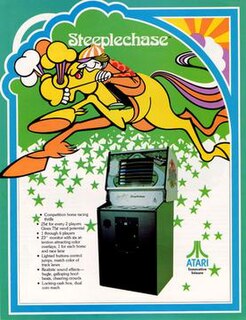 W
WSteeplechase is a 6-player arcade game by Atari Inc., originally released in 1975. Developed by Atari subsidiary Kee Games, it simulates a steeplechase-style horse race.